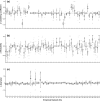The role of habitat configuration in shaping animal population processes: a framework to generate quantitative predictions
- PMID: 34159423
- PMCID: PMC8292241
- DOI: 10.1007/s00442-021-04967-y
The role of habitat configuration in shaping animal population processes: a framework to generate quantitative predictions
Abstract
By shaping where individuals move, habitat configuration can fundamentally structure animal populations. Yet, we currently lack a framework for generating quantitative predictions about the role of habitat configuration in modulating population outcomes. To address this gap, we propose a modelling framework inspired by studies using networks to characterize habitat connectivity. We first define animal habitat networks, explain how they can integrate information about the different configurational features of animal habitats, and highlight the need for a bottom-up generative model that can depict realistic variations in habitat potential connectivity. Second, we describe a model for simulating animal habitat networks (available in the R package AnimalHabitatNetwork), and demonstrate its ability to generate alternative habitat configurations based on empirical data, which forms the basis for exploring the consequences of alternative habitat structures. Finally, we lay out three key research questions and demonstrate how our framework can address them. By simulating the spread of a pathogen within a population, we show how transmission properties can be impacted by both local potential connectivity and landscape-level characteristics of habitats. Our study highlights the importance of considering the underlying habitat configuration in studies linking social structure with population-level outcomes.
Keywords: Habitat configuration; Habitat networks; Landscape connectivity; Movement networks; Social networks.
© 2021. The Author(s).
Conflict of interest statement
We have no conflicting interest with this paper.
Figures





References
-
- Albert R, Jeong H, Barabasi AL. Internet—diameter of the world-wide web. Nature. 1999;401:130–131. doi: 10.1038/43601. - DOI
-
- Alther R, Altermatt F. Fluvial network topology shapes communities of native and non-native amphipods. Ecosphere. 2018;9:e02102. doi: 10.1002/ecs2.2102. - DOI
-
- Altizer S, et al. Social organization and parasite risk in mammals: integrating theory and empirical studies. Annu Rev Ecol Evol S. 2003;34:517–547. doi: 10.1146/annurev.ecolsys.34.030102.151725. - DOI
MeSH terms
Grants and funding
- 850859/European Research Council (ERC) under the European Union's Horizon 2020 research and innovation programme
- EXC2117 - 422037984/DFG Centre of Excellence 2117 "Centre for the Advanced Study of Collective Behaviour" under Germany's Excellence Strategy
- 201706100183/China Scholarship Council
- 88881.170254/2018-01/CAPES-Brazil
- FA 1420/3-1/Deutsche Forschungsgemeinschaft
LinkOut - more resources
Full Text Sources
Miscellaneous

